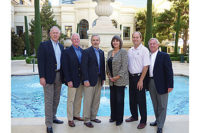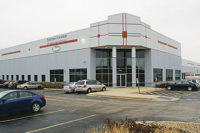Who says whatever happens in Vegas has to stay in Vegas?
In early September a blue-chip panel of six PHCP-PVF distributors gathered at the Bellagio in Las Vegas to take part in the fifth annual Supply House Times/American Supply Association roundtable discussion. During this exclusive interview conducted at the record-breaking NetworkASA 2014, the six distribution executives provided great insight and opinions on a variety of subjects currently on the industry’s front burner, including available credit, succession planning and the need for businesses to innovate. This year’s roundtable panel featured:
- Ted Green, CEO, Pace Supply, Rohnert Park, Calif.;
- Karla Neupert Hockley, President, Consolidated Supply Co., Tigard, Ore.;
- Scott Robertson, President, Robertson Heating Supply, Alliance, Ohio;
- Brian Tuohey, President, Collins Pipe & Supply, East Windsor, Conn.;
- Scott Weaver, President, APR Supply, Lebanon, Pa;
- Sam Williams Jr., President, Gateway Supply, Columbia, S.C.
The second installment of this interview appears in the January 2015 issue of Supply House Times.
Question: Is access to credit currently a problem?
The topic of the economy kicked off the 90-minute interview, but the discussion swung over to the subject of available capital for distributors.
“I don’t think having access to capital has ever been a problem in the history of the world if you are credit-worthy and I don’t see that changing,” APR Supply’s Weaver said.
Tuohey added, “We just completed several acquisitions which required some additional capital, and our rates have been lower than I have ever seen them and there were plenty of suitors.”
Pace Supply’s Green sees a somewhat different landscape at the construction level. “In our industry, I don’t think capital is a problem,” he said. “At the builder level credit has been a problem until just the past two years. I know a lot of builders who were affected.”
Robertson noted the availability of credit is coming at a good time for the industry. “We went a few years where the banking industry put construction in a not-preferred pile and was told to pull back in that sector. I don’t sense that today,” he said. “Companies with good credit records can get money and that’s certainly a need as we expand inventories and expand our companies.
“The economy is improving slightly and carefully and far from robustly. Everybody feels it’s going in the right direction, but not moving in any rapid way. Low single-digit growth is what you are dealing with. If you want that 8% to 12% growth you are going to have to go out and fight for it.”
However, Green cautioned there could be one wild card lurking out there in the credit game — interest rates. “It’s one of the things I’m always concerned about,” he said. “At some point, the Fed will have to raise the rates. The question is whether they can control the levels at which it happens and how fast it happens. If it gets out of control, it will have a massive effect on building construction.”
Question: Do you see pent-up capital sitting on the sidelines and projects on hold due to a lack of economic confidence?
The unanimous answer to this question centered around the panelists’ observations on what is happening in their local markets. “There are 20 cranes in downtown Seattle and several cranes in downtown Portland,” Neupert Hockley said. “Projects are ongoing right now and pent-up capital is being spent. It's more than normal multifamily activity — development really is happening. New subdivisions have been springing up in pockets the last 12-18 months and we didn't have any of that the previous four years.”
Green and Williams Jr., though on opposite coasts of the country, also have seen an uptick in housing construction.
“California housing is coming back,” Green stated. “A year ago we started to see it open up. This year, large housing tracks are going in. If you are selling your house, you will sell it for more than you put it on the market for because there is no housing available in certain areas around here.”
“The Myrtle Beach area was the first to go and it was the first to come back two years ago,” Williams Jr., added.
Others on the panel have benefitted from the prosperity seen in the industrial PVF sector this year. “There are a tremendous amount of gas wells going in related to the Marcellus shale,” Weaver said. “That has spawned the need for multifamily housing and temporary housing rather quickly in those pockets where the shale is.”
Tuohey pointed to a recent acquisition last year (Apex Remington Pipe & Supply) that has allowed his company to enter the oil and gas refining market. “We made that acquisition in Philadelphia a year ago specifically for access to the oil and gas arena, which historically is the largest purchaser of PVF products in the marketplace,” he said. “That single acquisition has allowed our company to experience strong double-digit growth in 2014.”
Robertson Heating Supply is seeing opportunities on multiple fronts, including remodeling and assisted living. “We are seeing indirect benefits from oil and gas. People are taking their big paychecks from their leases and building nicer places and hotels are going in,” Robertson said.
“After an attack such as 9-11 and a recession the definition of home and security has more meaning now. People looking to stay are putting more money into their homes so we’re seeing products going in above the baseline. We see assisted living opportunities continuing to grow with the aging population in the area. These are multiple little opportunities that when combined together give you reason for hope.”
Question: Does your company have a succession plan in place?
While this is a subject that has generated abundant discussions over the last year concerning companies’ level of preparedness, this panel has done its homework regarding plans of attack on the succession front.
“We’re family-owned and I have two brothers,” Williams Jr., said. “We talk about succession planning on a regular basis. We are second generation and looking at the third with a question and trying to address that. We're working at it more than we probably ever have.”
Neupert Hockley was part of an unexpected succession plan implementation when her father, industry great Karl Neupert, died in 2002. “It was sudden and tragic,” she said. “There wasn’t a strategic plan in the right-hand drawer and my brother and I were in middle management at best at the time. We weren’t ready. We had a trusted executive (Jeff Konen) step in and run the company for a few years — thank goodness. The last nine years we've been family-run again. Our fifth generation is between the ages of 13 and 21 and they are not going to be ready right away. We shall be moving forward with family-owned but not family-run for some amount of time until they are ready.”
Weaver falls into the same category as Consolidated’s future situation.
“When the current senior management group retires, the next generation will not be old enough to run a company our size,” he said. “We’ve identified a group (from the company’s emerging leaders program) to become senior managers and be nonfamily-run for 10 to 15 years before the next generation is ready.
“The other good thing is when family members turn 16 (APR Supply Chairman) Randy Tice sits down with them and lays out all the information they need to make a decision if they want to join the company — things such as going to college, working somewhere else for two years and getting an MBA if they want to be president. You can work here anytime, but if you want to be in management, this is what you have to do.”
Tuohey is in a similar situation and has a team in place to run the company in the interim until the next generation is ready. Collins also has hired a consulting firm to work with the next generation to prepare them to run the company in the future.
“Five years ago, my wife and I laid out the options to our children,” Tuohey said. “You can sell the company, or you can continue to own it, or you can own the company and work in the company. There are five children and they met among themselves and decided that the company culture and independence was worth preserving and they wanted to make Collins a legacy company.”
Green has kept Pace’s future on the high-priority to-do list. “We’re an ESOP (employee stock ownership plan) company,” he said. “We’ve evaluated our needs and training has been ongoing to fill those needs. We are looking at the growth we’ve had the last five years and where we are going in the future. Some of us are getting older. We need to look at those exit strategies. We’re writing up criteria for upper-management needs and how to fill those. All of this is on our board’s plate.”
Robertson added companies must also prepare for the financial component that comes with estate planning. “The sudden death of a majority owner can cause instant tax ramifications,” he said. “Many companies’ net worth is wrapped up in land and buildings and receivables, it’s not just cash sitting in drawers. If someone were to pass away unexpectedly there will be a large tax bill due that a company may not have the assets for without closing two or three branches.
“My grandfather, John Robertson, started when I was five gifting the company to me and my sisters. We’ve continued that with our 11 fourth-generation kids. We’ve done split-dollar insurance purchases early to help pay for taxes. The tax-planning piece is critical. It’s one of the key issues I follow with interest in ASA.”
Question: How important is paying attention to what your competition is doing?
Panelists here were somewhat divided on their responses, with all agreeing a focus on internal operations must be the first priority.
“We have branches on the showroom side that tell us these guys are doing this and that,” Williams Jr., said. “We have to concentrate on what we are doing and that’s what we constantly stress to our people.”
Weaver added: “We view that as looking in the rear-view mirror,” he said. “We want to be driving toward our goals and aspirations and helping our customers.”
Neupert Hockley said keeping abreast of competitive trends can be especially beneficial when it comes to new technology.
“It doesn’t change our mission, but you have to be aware and know what your customers’ experience is from wholesale house to wholesale house,” she said. “You need to be conscious of what the nationals are doing. Mobile apps that allow people to buy from a jobsite are one example. You need to know what’s out there.”
Question: What innovations are you employing to move your company forward?
Robertson noted his company’s newest distribution center features bar-code technology, thus creating greater efficiencies on multiple fronts. “Items are picked with a handheld computer gun that routes people through the DC,” he said. “Pick rates are about 14 picks per man hour now. We spent a lot of money long-term to be able to work on the distribution end of the business much more efficiently with the extra space and technology we are using.”
At the other end of the spectrum, Robertson is focusing more on customer trends. “If a customer is buying three of these things, why aren’t they buying these three other things?” he asked. “We’re spending more time on target marketing using basic technology skills. It’s growth through existing customers. They buy toilets, but why not faucets? These are good customers who like your company and want to do business with your company but don’t do business on related purchases. It will pay dividends.”
Neupert Hockley said Consolidated is focusing on data mining, going paperless as much as possible and creating an internal training program for permanent operations and logistics careers. “We feel that is a vital career going forward,” she said.
Green said showroom trends and operational enhancements are a big point of emphasis at Pace. “The showroom side is changing faster than we can keep up,” he said. “We’re selling to the end user and we in the wholesale business are not thinking to that retail mind. We must educate ourselves. Why aren’t we incorporating QR codes and Facebook and making it easier to communicate with the customer? We can’t get away with that anymore.”
Neupert Hockley asked who on the panel actively engages in Twitter communications. “We are working on Twitter and Facebook pages,” she said. “From a showroom and remodeling point of view, it’s a place you have to live. Our customers are selecting and looking online. If you are not able to be found out there where the customer can touch you, you are in trouble. We have to join the 21st century.”
Weaver added there is no shying away from change in this current business climate. “It’s up to us to change and adapt to what happens in the external environment,” he said. “As long as we change quicker, we will be the winners. If you stop innovating, those are the businesses that lose market share. The ones that continue to innovate and change will be the ones that prosper.”
Next month, the panel delves into topics such as health-care troubles, water heater regulations, hiring practices and their thoughts on current-day ASA and where it sees the association headed.
HELPFUL LINKS:









